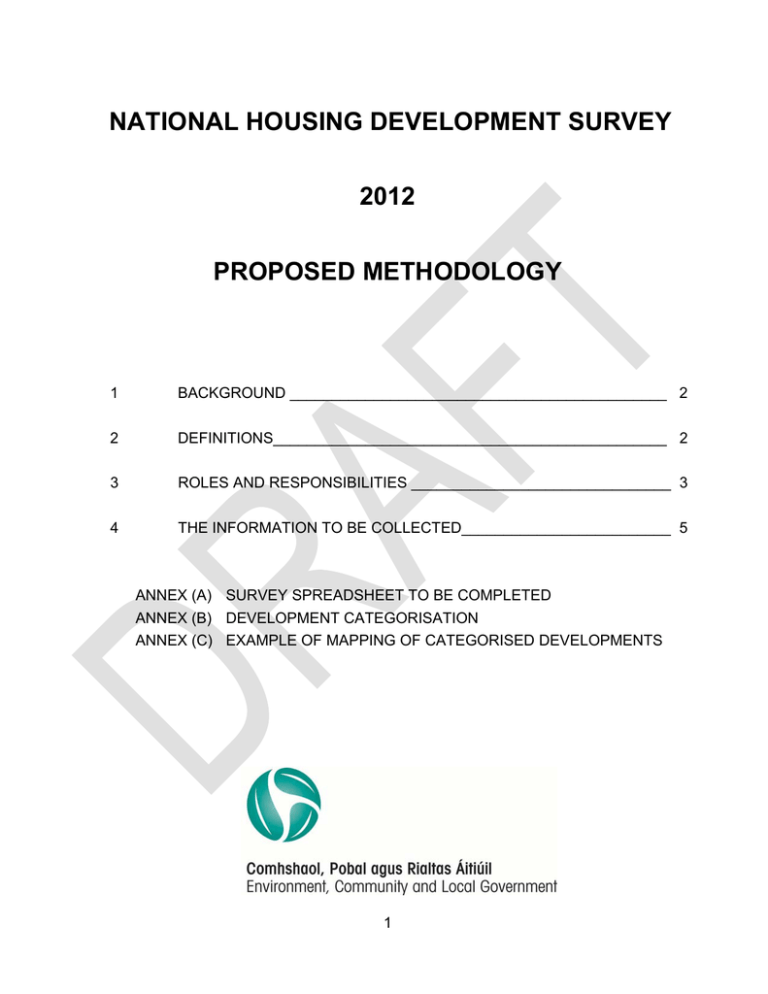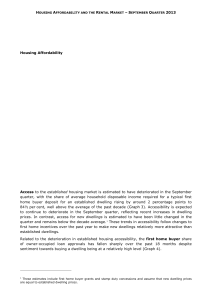NATIONAL HOUSING DEVELOPMENT SURVEY 2012 PROPOSED METHODOLOGY
advertisement

NATIONAL HOUSING DEVELOPMENT SURVEY 2012 PROPOSED METHODOLOGY 1 BACKGROUND _____________________________________________ 2 2 DEFINITIONS_______________________________________________ 2 3 ROLES AND RESPONSIBILITIES _______________________________ 3 4 THE INFORMATION TO BE COLLECTED_________________________ 5 ANNEX (A) SURVEY SPREADSHEET TO BE COMPLETED ANNEX (B) DEVELOPMENT CATEGORISATION ANNEX (C) EXAMPLE OF MAPPING OF CATEGORISED DEVELOPMENTS 1 1 BACKGROUND This document outlines the proposed methodology for the 2012 National Housing Development Survey (NHDS) to be conducted by the Department with the assistance of the local authorities and which is intended to update previous surveys in 2010 and 2011. 2 DEFINITIONS The survey is essentially an unfinished housing development completion status and condition survey. A ‘housing development’ would comprise two or more dwellings set out in free standing, semidetached, terraced, duplex and/or apartment formats. An ‘unfinished housing development’ is one where the approved dwellings and their associated services and amenities have not been completed and occupied. In order to create clarity it is necessary to elaborate on the two key underlined words. ‘Completed’ in this context does not necessarily mean that all the works required in terms of building regulations and/or the planning permission have been completed.1 Minor outstanding works, such as individual house electricity connections, entrance gates, decoration etc. would not be regarded as significant. A development will be regarded as finished if an Inspector considers, on the basis of a normal visual on-site inspection, that the following have been substantially completed: dwellings, roads and footpaths, lighting, water supply, waste water infrastructure, open spaces, as defined for the purposes of this survey. ‘Occupied’ in this context determines that there are individuals/families living in the unit. In cases where one or more sections of a development have been completed but no work has commenced on subsequent sections, then the development is not regarded as complete. 1 Planning applications may well have many conditions attached (20 – 30+ are not uncommon) many of which relate to different physical aspects of a project. It would be unrealistic and unnecessary to expect that as part of this survey the Inspectors become familiar with every relevant condition and then attempts to see if the conditions have been fully or partially met. 2 Determination by an Inspector of the state of completion of dwellings or any other aspect of a development will not imply any particular level of compliance with building regulations or planning permissions. 3 ROLES AND RESPONSIBILITIES The main tasks to be undertaken in the survey are set out below. Project Steering Committee The NHDS Steering Group has been re-established and in view of the collaborative approach to the 2012 survey between the Department and local authorities, its composition has been broadened to include representatives of the staff of local authorities likely to be engaged with the survey as well as representatives from the Housing and Planning Inspectorates and the Housing Agency. DECLG Architecture & Building Standards Inspectorate The Inspectorate, through each of the existing City/County Council UFHD Co-ordinators will be responsible for overall co-ordination of the survey, arranging for relevant local authority input where required through DECLG Regional Co-ordinators. Co-ordination will involve; Setting of report templates/spreadsheets; Arranging for survey to be carried out; In cases where the relevant Inspector considers that an uncompleted housing development comprises holiday homes (after making reasonable enquiries) the Inspector should survey the development and indicate in the comments space provided in the spreadsheet that it would appear to be a holiday home; Visit and survey the identified developments and fill in the standard Report Form (one for each housing development); Ascertain the most relevant Local Authority Planning Department reference number for the development (and the original or “master” pp ref in cases of multiple permissions); Obtain a copy of the overall approved development layout plan(s)2 from local authority in order to identify the total number of approved dwellings and the number of approved open spaces; Identifying any difficulties or need clarification on any issue; and Liaising with local authority based UFHD Co-ordinators. 2 Only approved layouts are of relevance. Layouts linked to outline planning permissions are not of any relevance in this context. 3 Inspectorate Managers (Regional Engineering Inspectors) The Manager’s tasks are: To agree work programmes relevant to survey with the Inspectors in their area; To provide the Inspectors with contact details of persons in the planning or other sections of the local authorities for which the Inspectors have responsibility; To provide such guidance and advice to the Inspectors as may be necessary; To obtain clarifications from members of the Steering Committee if necessary; To review the completed survey returns and obtain necessary clarifications from the Inspectors; To forward completed survey returns to Colum O’Ruanaidh; Provide a brief report indicating any problems, difficulties or concerns they may have regarding the coverage, quality of responses or any other relevant matter and when completed to send reports to Colum O’Ruanaidh; and To respond to queries as they may arise from time to time. Planning Inspectorate The Planning Inspectorate (DECLG) are responsible for: Notifying local authorities of the survey and obtaining contact names and details of persons in the planning or other sections with whom the Inspectors can make contact. Ensuring that survey returns are adequately incorporated into the Myplan system; Undertaking such analyses of the survey data as may be necessary and appropriate. Local Authorities Local authorities will be responsible for: Supporting the Departments Inspectors in carrying out the 2012 Survey; Sharing other relevant local authority data as regards unfinished housing developments; Confirm operative planning permission references for unfinished housing developments, the approved layout and approved scale of development (housing units); Where requested, to assist in site identification and access; To check the GIS coordinates on the www.myplan.ie website; and To check and clarify the names of developments. (including providing names in Irish within Gaeltacht areas) Where developments occur on county boundaries, the LA is to liaise with neighbouring LA to ensure that the development is counted (and not counted twice). 4 4 THE INFORMATION TO BE COLLECTED An example of the information to be collected about each unfinished housing development is set out in tabular form in Annex (A). All Inspectors will be provided with this template in Excel spreadsheet form and would need to fill their responses into the spreadsheet. For consistency and quality control, certain cells in the spreadsheet have been locked. In any survey it is important that the surveyors adopt a standardised approach in order to ensure comparability of the results. One of the important ways in which to obtain such an approach is to define terms and, where appropriate, to set out what has to be done to complete the various questions in the survey. The guidance set out below follows the numbered points in the spreadsheet set out in Annex (A). Department Development Reference Project Number This is the number(s) allocated to the project in the Housing Inspector’s filing system. Name of Development The name should be as provided in the planning application or as subsequently approved in the case of development names subject to agreement of the planning authority as part of a planning condition. Geographic Location This information needs to be checked on the planning Geographical Information System (GIS). www.myplan.ie Where errors occur one should contact Bruce McCormack (01 888 2490, bruce.mccormack@environ.ie) or Colum O’Ruanaidh (01 888 2725, colum.oruanaidh@environ.ie). The following information needs to be checked or provided where a new development is to be added and relevant parts of the development falling in to either or both of categories (A) and (B) identified and mapped using the Myplan system. Street Address/Townland (information to be provided in Irish and English for all Gaeltacht areas) Town, Village, Suburb Name Coordinates Boundaries of parts in Categories A and B. Planning Information The following information needs to be checked in relation to planning applications: 5 Planning Reference number(s) Planning Date Planning Expiry Date (NEW) (This may not necessarily relate to the original planning permission as extensions of time may have been applied for by the developer) Public Safety Initiative Funding Whether the development (or part thereof) has been approved for funding under the Departments Public Safety Initiative. Site Resolution Plan (SRP) Whether or not a SRP has been submitted to the relevant local authority by the owner, receiver and or funder of the development. Taken In Charge Whether or not the development (or part thereof) has been taken in charge by the relevant local authority. Housing Information The number of dwellings in each category needs to be either checked or updated. Five types of dwelling are identified: Detatched Semi-Detatched Terrace Duplex Apartment ‘Dwelling’ Completion Status In the case of each ‘dwelling’3 a number of levels of completion are to be recorded. Complete and Occupied Refer to the discussion regarding what is a complete ‘dwelling’ as set out in section 2 above. In the case of each completed ‘dwelling’ it is necessary to record whether or not the dwelling is occupied. A ‘dwelling’ may be regarded as being occupied if it shows signs of habitation such as having furniture, curtains, car in driveway, washing hanging out to dry, a dog in the garden, lights 3 The term ‘dwelling’ is used for this section in parenthesis because the survey will record the situation in relation to ‘dwellings’ which may be in various stages of completion, from pre-DPC level only to fully habitable. Thus the term as used here may refer to virtual dwellings. 6 on etc. If the Inspector is in any doubt regarding occupation it would be appropriate to ask locally about the status of the dwelling. Complete and Vacant A vacant ‘dwelling’ is one that although apparently habitable does not display all or most of the signs of occupation as indicated above. Near Complete (Roofed and Weathertight to Habitable) In this case the dwelling is weathertight but is not yet complete. In the case of each ‘dwelling’ at this stage it is necessary to indicate whether or not there is any building activity taking place on this ‘dwelling’ (Action or No Action) Wall Plate (Wallplate to Roofed and Weathertight) If the dwelling is at wall plate stage and beyond but is not yet weathertight (eg no, windows etc) then the ‘dwelling’ should be recorded as being at the wall plate stage. In the case of each ‘dwelling’ at this wall plate stage it is necessary to indicate whether or not there is any building activity taking place on this ‘dwelling’. (Action or No Action) DPC Complete (DPC Level to Wallplate Level) If the DPC has been fully laid but the ‘dwelling’ has not reached the wall plate stage as defined above then the ‘dwelling’ should be recorded as being at the DPC stage. In the case of each ‘dwelling’ at this stage it is necessary to record whether or not there is any building activity taking place. (Action or No Action) Foundations to DPC Level In the case of each ‘dwelling’ at this stage it is necessary to record whether or not there is any building activity taking place. (Action or No Action) No Start (No Construction Commenced In this case no construction work has commenced. Road, Access and Lighting Status This section of the survey records the extent to which the ‘dwellings’ in the development are served by roads, footpaths and lighting at varying stages of completion. 7 Roads Complete and In Service In the case of each ‘dwelling’, all of the roadways which are required to service that ‘dwelling’ (ie from the public road to the ‘dwelling’) need to have all courses (ie sub-base, base, final pavement) for the roads serving that ‘dwelling’ to be classified as being complete. Base Course/Binder Course Level If any part of the roadways servicing a ‘dwelling’ have only base course or a binder course (ie no final surface pavement) the relevant ‘dwelling’ should be recorded as being served by roads at base/binder course stage only. No Roads or Pre-base Level Course If any part of the roadways servicing a ‘dwelling’ have any road works which are below the base/binder course level (ie pre-base course) or have no works undertaken at all then the ‘dwelling’ should be classified into this category. Footpaths Record the number of ‘dwellings’ (occupied or vacant) that are serviced by a completed footpath. Lighting Record the number of ‘dwellings’ (occupied or vacant) that are serviced by a completed public lighting system. It is recommended that LA provide relevant information. Water Services It is recommended that LA provide relevant information. Potable Water Record the number of ‘dwellings’ (occupied or vacant) that have full water supply. Waste Water Record the number of ‘dwellings’ (occupied or vacant) that are serviced by a working waste water system. Storm Water Record the number of ‘dwellings’ (occupied or vacant) that are serviced by a working storm water system. 8 Open Space Record the number of open spaces. This information can be obtained from the overall estate layout plan. The intention here is to get an idea regarding the level/stage of development of all the open spaces identified in the overall master layout plan(s). The level of completion is based on the criteria below; Completed A completed open space is an area which has been contoured (levelled) and grassed or seeded, or possibly hardened (fully or partially). Levelled, not seeded or hardened An open space may be levelled but no seeding (or hardening) has been undertaken in which case it is recorded as such. In order to record an open space as being levelled it is necessary that the whole open space has been levelled, possibly apart from some minor edge areas. Untouched, substantially untouched An open space which is classified as untouched or substantially untouched is an area in which in all or at least half of the space no attempt has been made to prepare the open space. Inactive Site or Inactive Part of Site Access On inactive sites (or inactive parts of sites), it is necessary to record (Yes or No) if there is ready access to incomplete construction works, open trenches or other obvious hazards due to missing fencing, gaps in fencing or other protection. Inspector’s Name If more than one Inspector participated in the inspection then all the Inspectors names should be recorded. Date of Survey Completion If the site was visited more than once on different days in order to undertake this survey then only the date of the final visit should be recorded. Any Overall Comments Space is provided for any general comments which the Inspector may wish to make on any aspect of the survey. If it would appear that the development constitutes holiday homes then this should be recorded here. 9 ANNEX (A): PROTOTYPE SURVEY SHEET 10 ANNEX (B) UNFINISHED HOUSING DEVELOPMENTS IN A SERIOUSLY UNSATISFACTORY CONDITION General In assisting the completion of the 2012 National Housing Development Survey, each Local Authority must identify any unfinished housing development (UHD), or any part thereof and the individual dwellings concerned that are in a seriously unsatisfactory condition. In arriving at this qualitative assessment, each Local Authority will apply the criteria below. Unfinished housing developments in a seriously unsatisfactory condition will be prioritised for action in ensuring the owner/developer/funder addresses the concerns or where this is not possible, in addressing urgent public safety type issues through the DECLG Public Safety Initiative. The Department will establish a secure web browser containing ordnance survey mapping and easy to use drawing tools (similar to the Myplan facility) onto which local authorities will be responsible for indicating the overall development boundaries of each unfinished housing development in blue (as represented by the relevant planning permission) and the boundaries of developments or parts thereof falling into this annex (Unfinished Housing Developments in a Seriously Unsatisfactory Condition) outlined in red (see Annex C). A further communication from the Department will outline the relevant procedures for this mapping process in the near future. Criteria A dwelling unit should be deemed to be in a seriously unsatisfactory condition if, in the opinion of the relevant Local Authority the following essential public infrastructure and amenity standards have not been met: Installation and commissioning of public lighting; o subsequent maintenance issues such as individual lamp standards not working etc. should be discounted; Provision of potable water supply; Provision of wastewater collection, treatment and disposal systems (if provided on a standalone basis to serve the particular UHD) sufficient to ensure that, in the opinion of the local authority, no pollution or public health issues are arising; Access road to at least base course level; o including, where required, provision for parking; 11 Provision of access to the dwelling by constructed footpath; Provision of open space capable of serving the amenity needs of permitted dwellings; and o being suitable for access and use by members of the public. Deficiencies in the landscaping (e.g. tree planting) of public open space or similar would not render a development to be in a seriously unsatisfactory condition. In addition, for developments constructed in phases, access to public open space meeting the criteria above in other phases of the development is sufficient. 12 ANNEX C: Screen Grab example of an unfinished housing development with the overall development boundary in blue and that part of the development falling into Annex B outlined in red. 13


